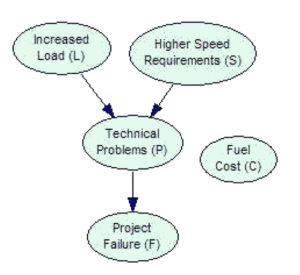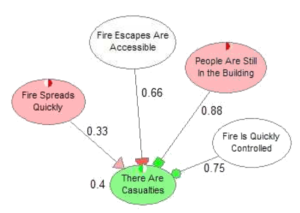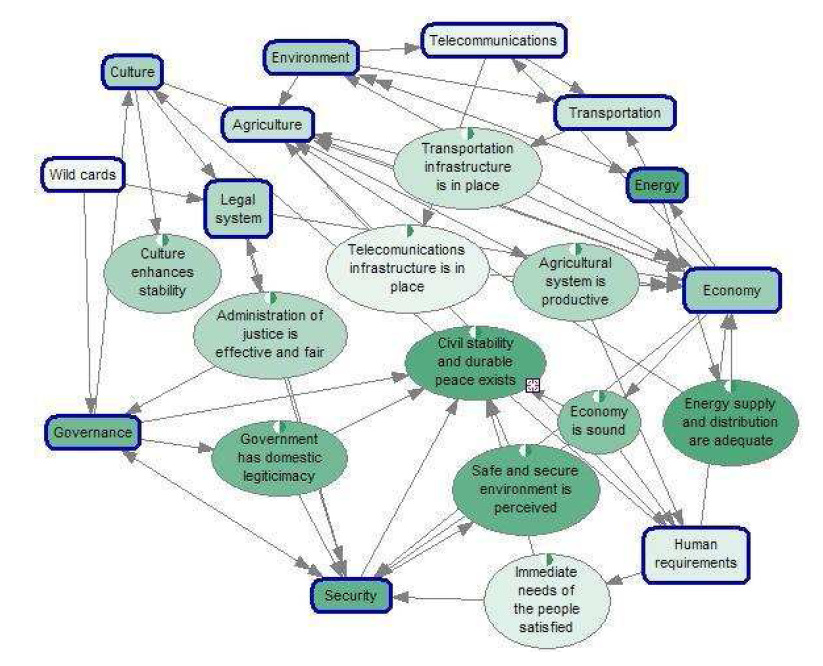Good planners don’t just extrapolate the present into the future. They engage themselves in alternative futures exercises. They identify the assumptions upon which decisions are being made and question each one of them for their validity. And they ask a lot of “what if” questions. Determining answers to complicated “what if” questions is not a simple matter however. Professor Marek J. Druzdzel, from the University of Pittsburgh, writes:
“One way of supporting business decisions is through creation of business models and subsequent exploration of such models by means of ‘what if’ questions. This approach requires that the models are causal, i.e., when the ‘what if’ question involves any kind of manipulation of the system, the model is able to predict the effects of this manipulation. For example, when asked the question ‘What if we introduce the third shift on the factory floor?,’ the model should be aware that this will change the production capacity, it will increase the costs, but will not impact the customer orders or market price of raw materials or the products.” [“Rapid Modeling and Analysis with QGENIE,” Proceedings of the International Multiconference on Computer Science and Information Technology, Volume 4, 2009].
QGeNIe, stands for Qualitative GeNIe (Graphical Network Interface), a software package can be used to create decision theoretic models intuitively using the graphical click-and-drop interface and it is a special version of GeNIe, which is the graphical interface to SMILE, a fully portable Bayesian inference engine developed by the Decision Systems Laboratory at the University of Pittsburgh. GeNIe has been thoroughly tested in the field since 1998. Both GeNIe and SMILE are available for downloading at on the DSL site. According to Druzdzel, “QGeNIe is an attempt to build an ideal system, i.e., one that allows for rapid construction of causal models, that has an intuitive user interface, and that is fast enough to offer an “instant gratification” interface.” He continues:
“Technically, QGeNIe is a specialized version of GeNIe, a decision modeling environment developed by the Decision Systems Laboratory, University of Pittsburgh. GeNIe has over 20,000 users worldwide and is slowly becoming a standard tool in research and in teaching such topics as probability and decision theory. It has also been used in several business and industrial applications. All variables in QGeNIe are propositional, almost no numerical probabilities are displayed at the user interface, and posterior probabilities (interpreted as degrees of truth of propositions) are displayed by means of node colors. All numerical parameters, such as prior probability distributions over variables and strengths of influences between variables, are entered by means of graphical sliders. While the underlying computations are all numerical and based on Bayesian updating, QGeNIe makes the impression of a qualitative, ‘order of magnitude’ type system that aids rapid model building and an approximate analysis of systems.”
 In other words, what the user sees are color-coded nodes with established, weighted relationships. When the user asks “what if” questions (by changing the color of one of the nodes through a slider bar, i.e., changing its value from one state to another), the colors throughout the remainder of the network also change to show the impact of the “what if” situation. As a result, a user can immediately see the overall effect of a single change. If the relationships and weights are correct, this kind of model can help discover unintended consequences (good or bad) of seemingly minor changes to a system. It can be a very powerful tool in decision making. The attached figure shows what a highly simplified Bayesian network might look like to a user. Druzdzel continues:
In other words, what the user sees are color-coded nodes with established, weighted relationships. When the user asks “what if” questions (by changing the color of one of the nodes through a slider bar, i.e., changing its value from one state to another), the colors throughout the remainder of the network also change to show the impact of the “what if” situation. As a result, a user can immediately see the overall effect of a single change. If the relationships and weights are correct, this kind of model can help discover unintended consequences (good or bad) of seemingly minor changes to a system. It can be a very powerful tool in decision making. The attached figure shows what a highly simplified Bayesian network might look like to a user. Druzdzel continues:
“Typical environments where it has proven useful [include]: modeling in ‘soft sciences,’ brainstorming sessions of the strategic planning type, involving multiple decision makers. Session participants may not be able to specify the exact numerical values of the interactions, but they will typically agree on the structure of the problem and the rough magnitude of the influences between variables. Instant feedback to ‘what if’ questions based on the model allows for quick analysis of the model and reaching consensus and conclusions in group settings.”
If you are interested in the math behind QGeNIe, Druzdzel provides a rich discussion of the formulas used as well as a discussion about Bayesian Networks. He notes:
“The hardest problem with Bayesian networks, commonly perceived to be the bottleneck in their practical application, is model construction. While building the structure of a Bayesian network is perceived doable, obtaining large quantities of numbers to parameterize them is hard. These, stored as conditional probability tables (CPTs) inside each of the nodes of the graph, grow exponentially in the number of parents of the node. Because nodes with more than 10 parents are not uncommon, this may mean huge quantities of numbers. One way of handling this problem, directly relevant to the approach taken in this paper is introduction of so called ‘canonical models’ and especially their subset, the Independence of Causal Influences (ICI) models. ICI nodes provide a solution to the problem of quantification of Bayesian networks by assuming that parent variables cause the effect independently of each other. The benefit of this assumption is such that the number of required parameters is linear, rather than exponential, in the number of parent variables. … Of interest in a system like QGeNIe are such ICI models that are capable of modeling real-world interactions among variables in models. Such interactions may be of a variety of types, although as a minimum one has to be able to model opposing influences, i.e., combinations of influences that increase, and decrease the posterior probability of the child variable. This is important because in practice we always deal with factors that have positive and negative influences. The same variable may have a positive influence on one variable and a negative influence on another.”
Fortunately, for the mathematically challenged among us, all of the calculations in QGeNIe take place behind the interface. A “parent” node is one that causes an effect on another node (the child). Druzdzel introduces some other terms that are helpful in understanding the qualitative model he is discussing. There are, he writes, “four fundamental types of cause-effect interactions: Cause, Barrier, Requirement, and Inhibitor. He continues:
“Because the effects of the four types of parents are different, their distinguished states are also different. 1) Cause: The distinguished state of a cause is the state in which the cause has no effect on the child. For example, ‘not being a smoker’ has no effect on ‘lung cancer’ in [a diagnostic model]. ‘Not being a smoker’ is the distinguished state in this interaction. So is ‘having no cancer.’ 2) Barrier: The distinguished state of a barrier is also the state in which the cause has no effect on the child. For example, ‘exercise’ may be thought as not influencing the risk of ‘heart disease.’ ‘Exercise’ is the distinguished state in this interaction. So is ‘no heart disease’ in the child node. 3) Requirement: The distinguished state of a requirement is the state that is necessary for the effect to take place at all. For example, ‘being a female’ is a requirement for becoming pregnant and it is the distinguished state in this interaction. ‘No pregnancy’ is the distinguished state of the child node. 4) Inhibitor: The distinguished state of an inhibitor is the state that has no effect on the child, i.e., the inhibiting factor being absent. For example, ‘rain’ is an inhibitor of wild land fire. Its distinguished state is ‘rain,’ in which case the fire may not happen.”
 It should be apparent from this brief description of the QGeNIe model that it can be used in any number of situations where relationships are important and complex. If, for example, you are in the firefighting business and are trying to prevent casualties, a simplified model might look like the one attached. In this simplified model, it’s clear that if the fire spreads quickly and people are still trapped in the building then the likelihood of casualties increases (hence the green color of the child node). This kind of a model could be used to help in the reconstruction or revitalization of community following conflict or a natural disaster. By modeling community relationships, analysts could quickly determine which activities would have the greatest potential benefit and might even help determine which order activities should be accomplished.
It should be apparent from this brief description of the QGeNIe model that it can be used in any number of situations where relationships are important and complex. If, for example, you are in the firefighting business and are trying to prevent casualties, a simplified model might look like the one attached. In this simplified model, it’s clear that if the fire spreads quickly and people are still trapped in the building then the likelihood of casualties increases (hence the green color of the child node). This kind of a model could be used to help in the reconstruction or revitalization of community following conflict or a natural disaster. By modeling community relationships, analysts could quickly determine which activities would have the greatest potential benefit and might even help determine which order activities should be accomplished.
You might wonder how Professor Druzdzel’s paper came to my attention. It was actually forwarded to Enterra Solutions’ Senior Director of Communications and Research, Bradd Hayes, by a former colleague because the two of them worked with Dr. Druzdzel on an early version of QGeNIe. In fact, in the paper Druzdzel notes:
“The original inspiration for QGeNIe was provided by our collaboration with policy analysts at the United States Naval War College, Bradd Hayes and Theo Gemelas. A model developed there … consisted of 99 variables organized into 12 submodels. The goal of this model was to bring together experts from a variety of areas relevant to stability of a region (in this case, the Black Sea region).”
The attached figure shows some of the nodes that were taken into consideration when the analysts were trying to figure out relationships necessary to foster civil stability and sustainable peace. Without a model like QGeNIe, trying to do quick “what if” analyses is impossible. The beauty of QGeNIe is that it provides a clear visual presentation of what is happening as variables are manipulated. By returning the status quo state, any number of “what if” combinations can be examined. As Druzdzel concludes, “QGeNIe is useful in rapid modeling of problems involving propositional variables.” If you are interested in Bayesian networks, diagnostics, “what if” analysis, or mathematical models in general, I recommend that you read Professor Druzdzel’s paper and visit the DSL website. Who knows, you might even be able to help advance the state of the art.





